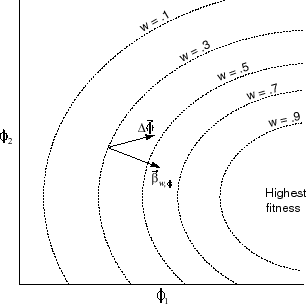
Homework problem
Consider the following data for Beak Length in Buntings (a bird):
| Midparent | Offspring | |
| 12.61 | 12.36 | |
| 12.66 | 12.49 | |
| 12.77 | 12.59 | |
| 13.26 | 12.79 | |
| 13.41 | 12.83 | |
| 13.41 | 13.02 | |
| 14.16 | 13.54 | |
| 14.41 | 13.49 | |
| 15.04 | 13.78 |
1) Plot this data.
2) Calculate: The mean values for midparent and offspring Beak length.
3) Calculate the offspring-midparent covariance, and the variance in midparent values.
(see Handout)
4) Find the heritability of beak length in these birds.
***************************************************************************
Quantitative genetics (cont.)
Recall the matrix equation for the joint evolution of two traits:

Or, simply:

Here, the vector of partial regressions of fitness on the phenotypes:

is the Fitness Gradient; a vector pointing in the direction of maximum increase in fitness.
This form of the equation is useful both because it applies to any number of characters (just make the matrix and vectors bigger) and because it illustrates that with covariation between the characters, selection does not necessarily move the population along the quickest rout uphill (which would be the gradient).
The figure on the left below illustrates the fact that if there is no genetic covariance between two traits, then the direction of evolution is the same as the direction in which fitness would increase most quickly.
Furthermore, selection can cause a character to change in a maladaptive way if it covaries with another character that is under strong selection.
Consider the illustration below, illustrating the joint evolution of two characters that are correlated (correlation = 0.6):

In this case, the quickest way to increase fitness would be to increase 1 and decrease
2 (i.e. following the fitness gradient,
 ).
).
However, because the traits are positively correlated, 2 increases.
Example: Galapagos Finches
Studied by P. and R. Grant
Birds followed (by marking individuals) for many years.
In 1977, a drought meant that there were far fewer seeds than usual, and those that remained were large. This imposed selection for birds with deep beaks.
By contrast, having a long beak was detrimental because of leverage problems.
Based just on observed changes:
Sdepth = 0.3
Slength = 0.21
So both length and depth increased.
However, calculating partial regressions (which hold other factors constant) of fitness on these traits produced:
 w,depth = 0.43
w,depth = 0.43
 w,length = -0.17
w,length = -0.17
So long beaks are selected against. Length increased because of high covariance with depth. Jul 8, 2021